- Images
- Blog
- Tools
- Questar
- The Questar telescope
- Questar resource links
- Search for Questar info
- 172mm Focal Reducer
- Afocal adapter for point and shoot camera
- Camera adapter lengths
- Camera adapter threading
- Camera connection
- Camera focusing
- Custom counterweight
- Drift Alignment Joy
- Finder Eyepiece Compatibility
- The Questar Moon 1981
- Questar Powerguide II Battery Life
- Questar Zone, How to Service Videos
- Red Dot finder mount for Questar
- Questar Viewing Table
- Wedge mounts
- White light solar filters comparison
- How to
- Get started in astronomy
- Astro RaspberryPi Camera and kin, the ASIAir and StellarMate
- Blind Smart-phone Equatorial Wedge or GEM Polar Alignment
- Camera phone adapter
- Celestron FirstScope with equatorial tripod mount
- Coat Pocket Astrophotography
- Day-lapse Images of Earthshine on the Crescent Moon
- Dobsonian Carrying Case
- DSO Astrophotography without a Telescope
- DSO imaging without a star tracker
- Estimating image resolution
- Lunar Eclipse Photography
- Moon photography - a dozen ways to shoot the Moon
- Meteor shower photography & planning
- Matching image sensor size to telescope resolution
- Narrow band imaging with color cameras
- Planetary Image Workflow
- Print and Display Astrophotography
- Observing
- Events
- More
- About
- Contact
ACEAP 2019: ALMA Radio Telescope
Where do we come from? What are we? Where are we going? Questions as old as mankind. The search for answers impels many quests including the painter Gauguin’s voyage to Tahiti. Today, it draws astronomers to the remote Chajnantor plateau in the Chilean Andes. The Atacama Large Millimeter/sub-millimeter Array, ALMA, Array Operations Site hosts the most powerful telescope on earth.
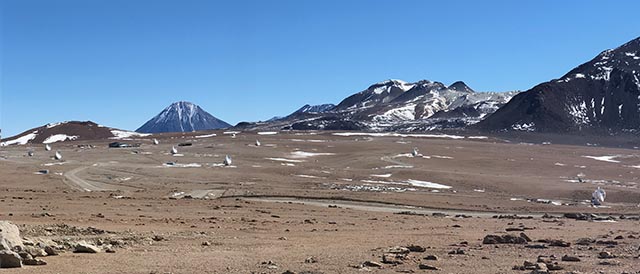
ALMA 12 meter antennas, Credit: R. Pettengill (NRAO/AUI/NSF)
With 16,500 feet of altitude at the AOS, supplemental oxygen is required. Nearby in a more sheltered location, at 10,000’ high is the ALMA Operations Support Facility in the Atacama Desert. OSF hosts the couple hundred scientists, engineers, and staff needed to operate and maintain the telescope. The massive amount of data produced by ALMA requires reduction, archive, and distribution centers on four continents to deliver observational data to investigating scientists.
The dedicated staff of a couple hundred at the OSF with the dozen or two essential personnel at AOS during the day, must cope with isolation and separation from family and comforts of home. Most commute from Santiago and face about about a 6 hour commute, including the two hour flight. A common shift is 8 work days and 4 days off. Staff with families far away may spend 6 months apart. Pride, intelligence, and sense of purpose shone in everyone we spoke with from the director Sean Dougherty to the casino staff. Don’t get excited, casino is Chilean for cafeteria!
All together, including the thousands needed at supporting locations, ALMA is a knowledge factory helping answer these profound questions. The ACEAP 2019 cadre were thrilled to have the rare opportunity to stay overnight at the OSF and make the 45 minute trip for a two hour stay at the AOS high site. In exchange we all are sharing our experiences.
The day before included a tour of the OSF and presentations including one about ALMA’s role in the Event Horizon image of the M87 black hole shadow. New capabilities for signal polarization measurements will enable understanding of the motion of targets.
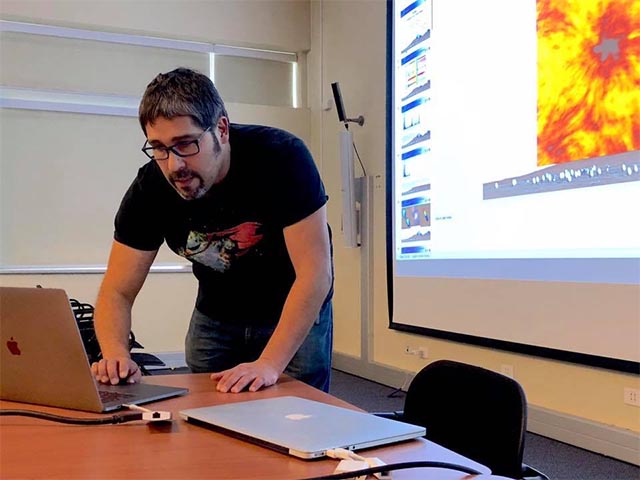
Paulo Cortes, Credit: R. Pettengill (NRAO/AUI/NSF)
Paulo Cortes, the ALMA operations astronomer, dreamed of being a truck driver in a Chilean public school. His high school physics teacher prepared Paulo and a few others for university entrance exams. Now the whole world benefits from his talents and many others like him. Thank teachers! Just one small example of the human capitol available to answer questions and solve problems that have proven too difficult for developed world alone.
The lights of this large engineering and residence complex did nothing to dim the spectacular Atacama view of the Milky Way and Jupiter
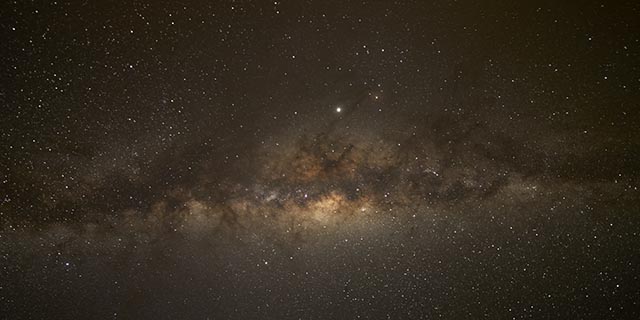
Jupiter above the Milky Way from ALMA OSF, Credit: R. Pettengill (NRAO/AUI/NSF)
In the morning, not only did the ACEAP 2019 team have to pass a medical exam before proceeding, but drivers to the high site must pass one before every trip. Visitors are allowed a maximum of a 2 hour visit. Essential staff are limited to 6 hours. No one is permitted to stay overnight. The day before our visit, staff was evacuated due to high winds.
We were fitted with our oxygen, then crammed into two trucks for the 45 minute trip. The road is straight and wide for a mountain road, because it used to transport the giant dish antennas. A majestic snow capped volcano dominated the view to our left. We also encountered several groups of wild vicuña. Near the AOS the ground looks remarkably like rover images of Mars with the blue sky the only hint that we are still on earth.
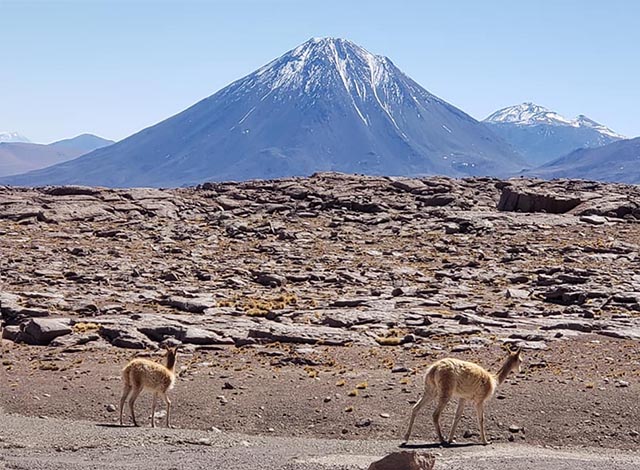
Road to ALMA AOS with vicuña and the Licancabur Volcano. Credit A. Borja: (NRAO/AUI/NSF)
After a brief stop at the small engineering building with the correlators that combine signals from the antennas, we begin touring the array.
ALMA includes both smaller antennas for sub-millimeter signals and larger ones for longer wavelengths. There are a total of 66 antennas: 54 twelve meter and 12 seven meter dishes. Antennas made in the US, Europe, and Japan have distinctive looks and parts, but function identically.
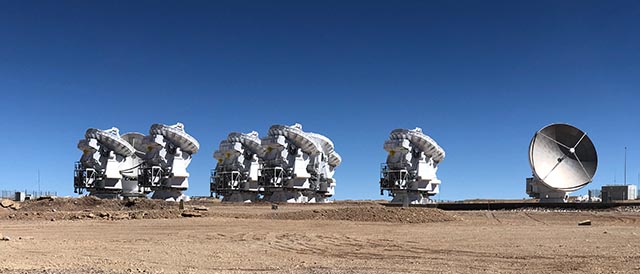
Japanese 7m dishes and European 12m dish in the compact array, Credit: R. Pettengill (NRAO/AUI/NSF)
We were lucky with a calm sunny day, but looks are deceptive. My roommate Art discovered his oxygen line was pinched when his fingertips started to become numb.
Huge antenna transporters position the dish antennas on mounting pads with sub-millimeter precision. A visit with Otto the transporter was a highlight worthy of a group picture.

The ACEAP 2019 team with Sonia Daffau and our ALMA driver in front of Otto the transporter and an American dish. Credit: V. Foncia (NRAO/AUI/NSF)
The ACEAP team went from ALMA to visits at the wonderful Tata Mallku Park and Valley of the Moon near San Pedro. Back in Santiago we were introduced to the powerful ESO observatories that will have to wait for others visits. The big picture of astronomy and economic development in Chile was given by Luis Chavarria, Director of Astronomy at Chile’s CONICYT.
I left with profound admiration for those who have created one of the great scientific enterprises of history in Chile. Thanks to the NSF, AUI, and National Optical and Radio Astronomy Observatories for making this trip possible. Learn about ACEAP and meet the 2019 and previous cadres at AstroAmbassadors.com. I’m entranced by the warmth of the people of Chile and the wonderful food and wine. The Texan in me may smuggle in a little hot sauce on the next visit, because the astrophotographer in me has to go back.

Even the familiar Moon takes on a new look in the Atacama. Earthshine on the crescent moon takes on colors of the desert as it sinks behind a ridge, from the ALMA OSF Residencia. Credit: R. Pettengill (NRAO/AUI/NSF)
For more about this trip, more images, and press articles see: ACEAP 2019 or #ACEAP2019 #AstroAmbassadors #NSFfunded on social media.
Content created: 2019-08-04
Comments
![]() Submit comments or questions about this page.
Submit comments or questions about this page.
By submitting a comment, you agree that: it may be included here in whole or part, attributed to you, and its content is subject to the site wide Creative Commons licensing.

Blog
Silver City Heart & Soul Nebulae Revisited
Medulla or Garlic Nebula, CTB1, Abell 85
Nebulae afire off the belt of Orion
City Lights Horsehead & Flame Nebulae
Flaming Star Nebula dark sky vrs city sky face-off
Christmas Tree Cluster and Cone Nebula with more exposure
Christmas Tree Cluster with the Cone Nebula
Horsehead Nebula Face-Off Bortle 2 vrs Bortle 7
California Nebula Face-Off Bortle 2 vrs Bortle 7
Western Veil Nebula from Marfa
Trifid and Lagoon Nebulae Drizzle Stacked
North America and Penguin Nebulae Drizzle Stacked
Return to Coconino Andromeda, M31
Revisiting the Willow House Rosette
Corazón Incendida, the Heart Nebula
Elephant Trunk with the Garnet Star
Balanced HO North America & Pelican Nebulae
The Lagoon & Trifid Nebulas from Marfa
Western Veil Nebula from Marfa
The Great Winter Solstice Conjunction of Jupiter and Saturn
Two days to the Great Jupiter Saturn Conjunction
Worlds Apart, the Jupiter Saturn Conjunction
Raspberry Pi HQ camera first light
Waxing Crescent Moon with earthshine and stars
Vixen Porta II mount adapter or aluminum disk with holes #2
The 2019 ACEAP Expedition to Chile
Universe of Stories: Getting Started in Astronomy
View an Apollo flag on the Moon from Earth?
Apollo 50th is my 24th Flickr Explore Selection
Shooting the video stars - Moon and Jupiter
Ready for a change in perspective
Jupiter and the Galilean Moons through a camera lens
2022 the Solar System in one view
As hard to see as a doughnut on the Moon
Santa Inez miners church Terlingua
Waning gibbous Moon early Christmas Eve
Christmas eve on the eastern limb of the Moon
Mars at 23.3 arc sec with Syrtis Major
BadAstroPhotos Web Site Analytics
Saturn with Pixinsight workflow
Mars Update from Mauri Rosenthal
Waxing Gibbous Moon Terlingua Texas
Io Transit of Jupiter with the Great Red Spot
Not so bad Astro after 2 years
Eyes of the Llama from Urubamba
Moon and Venus over Cusco's El Monasterio
Tiangong-1 Space Station reentry tracking
Apollo - 50 years of human footprints on the Moon, complete!
Waxing Crescent Moon after Astrophotography Meetup
The Great American Eclipse from Above and Below
A million astro photo views on Flickr
Ansel Adams: Moonrise, Hernandez, New Mexico
December Solstice Crescent Moon with Earthshine
January 31 Blue Moon Lunar Eclipse
The Total Solar Eclipse in half a minute
2017 Solar Eclipse from a million miles away
Longhorn Eclipse from a Wyoming Hilltop
Fibs, damn lies, telescopes, and astrophotography
Full Moon before Total Solar Eclipse 2017
Longhorn Crescent Moon from Austin
The Crescent Moon with Jupiter and moons
Eye of the storm 2 - Juno & Jupiter's Great Red Spot
Eye of the storm - Juno & Jupiter's Great Red Spot
A million miles from earth, the Moon and earth east and west
Saturn with Titan, Dione, Tethys, & Rhea
Animated transit of Jupiter by Io
Solar Eclipse 2017 Highway Traffic Map
Mid-South Star Gaze + Questar Meet
Sweet Home Alabama Transit of Jupiter by Io
Update on AutoStakkert on macOS
Diffraction is not the limit for digital images
Teasing life into planetary images
Moon camera comparison: DSLR & planetary cameras
Waning Crescent Moon with Earthshine
1st day of Spring last quarter Moon
Lewis Morris Rutherfurd's Moon
Super Moonrise over Lady Bird Lake
360 Tower pierces the Super Moon
Lisbeth's Birthday Crescent Moon
The Moon and Mars from the Astro Café
Silent and Mechanical Shutter Comparison
Austin's Solar Sidewalk Sun-Day
Another Longhorn Moon over Austin
Jupiter and Venus do a father-daughter dance
Sunset with Mercury, Jupiter, and Venus
Mercury, Jupiter & Venus after sunset
3 months, 92 nations, 3750 visitors, 100,000+ images served
Upcoming Conjunction of Jupiter & Venus
The Perseid Meteor Shower with the Andromeda Galaxy
Waxing crescent Moon from UHD Video
NWS Interactive Digital Forecast Map
M7 the Ptolemy Cluster preview
Five Planets in the Sky at Dusk
Lucky Fat Waning Crescent Moon
Two months, 80 nations, and an embarrassing bug
Saturn with 5 moons: Titan, Rhea, Enceladus, Tethys, & Dione
The nearly full Moon and Saturn with a short tube refractor

 2025
2025
